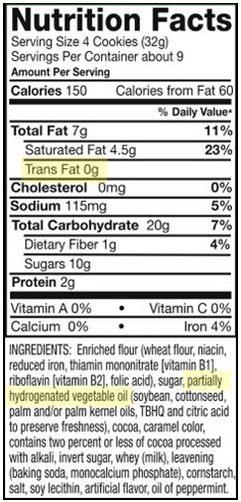On June 16th, 2015 the U.S. Food and Drug Administration (FDA) ruled that partially hydrogenated oils (PHOs) —which are the main source of trans fat—are no longer generally recognized as safe. Companies have until 2018 to remove PHOs from their products, meaning that trans fat will be eliminated from the American food supply within the next three years.
What is trans fat?
Trans fats are popular in the food industry because they increase the shelf life of oils and they make margarine easier to spread. They also provide a lighter, flakier texture to baked goods and a unique creaminess to pudding and frosting. However, the negative health effects of trans fat outweigh their uses in the kitchen.
What does trans fat do?
Trans fat increases the amount of “bad cholesterol” in the bloodstream and decreases the amount of “good cholesterol.” This effect increases the risk of death from heart disease and strokes. Therefore, the decision to eliminate it from the food supply is intended to improve public health and save thousands of lives each year.
Identifying trans fat
Many manufacturers already have removed trans fat from their foods. For example, Starbucks and Tyson Foods did away with trans fats in 2007. For the next few years, however, some foods may continue to contain PHOs as manufacturers who haven’t yet removed trans fat work to phase out the ingredient. To determine if trans fat is in a food, check the nutrition label under fat.

Notice in this example that even though Trans Fat reads 0 g., the ingredient statement shows that the food contains partially hydrogenated oil. Therefore, the product does contain some trans fat, but due to current labeling laws, if there’s less than 0.5 gram trans fat per serving, it can be labeled as zero.
So far we have been discussing artificial trans fat, which is a man-made substance. However, it’s important to note that small amounts of trans fat occur naturally in some animal products, such as meat and milk. There have not been sufficient studies to determine whether naturally-occurring trans fats have the same negative effects as industrially-manufactured trans fats.
Whether the trans fat is artificial or natural, it is best to limit intake of this substance. Some foods that may still contain trans fats include:
- Margarine.
- Butter.
- Shortening.
- Doughnuts.
- Cookies.
- Crackers.
- Muffins.
- Pies.
- Cakes.
Good Food Service maintains nutrition information for in-stock products. To find out whether an item contains trans fat, visit Gordon Experience, locate a product within the catalog or on your order guide, and click on the Nutrition tab.
Sources:
http://www.fda.gov/NewsEvents/Newsroom/PressAnnouncements/ucm451237.htm




























